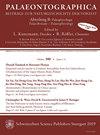印度贾坎德邦Damodar盆地东Bokaro煤田地下含煤层孢粉测年
IF 1.6
3区 地球科学
Q2 Earth and Planetary Sciences
Palaeontographica Abteilung B-Palaeophytologie Palaeobotany-Palaeophytology
Pub Date : 2012-03-02
DOI:10.1127/PALB/288/2012/41
引用次数: 11
摘要
对达摩达尔盆地东Bokaro煤田东部Muditoli区块的第一个地层井EBM-1进行了孢粉含量测定。Gondwana沉积物厚度约为1185.00 m,由绿页岩、碳质页岩、砂岩和煤层组成,在bare Measures组和Barakar组中显示出多种水平的孢粉组变化模式。在1198.30-1095.25 m之间,试样呈深棕色,外表面扭曲。放射状单囊花粉分类群的存在证明该地层与早二叠世Talchir组有关。在上剖面上,有丰富的粉粒花粉、细粒花粉、密粒花粉和纹足石。这些分类群的相对丰度划分了所研究地层孢粉层序在1086.95 ~ 13.00 m的不同层次。因此,推断这些矿床包含有代表性的早至晚二叠世孢粉组合。Lundbladispora micro - conata、Playfordiaspora cancellosa和Arcuatipollenites pellucidus在13.00、51.50和66.70 m深度的FAD增强了二叠纪末期的水平,因为这些元素是二叠纪向下三叠统过渡的关键物种。在这个完整的演替中,不同深度的非生产性地层含有丰富的木屑和植物物质,而较少的岩形物,这可能是由于二叠纪时期沉积物中的沉积构造所致。本文章由计算机程序翻译,如有差异,请以英文原文为准。
Palynological dating of a subsurface coal bearing horizon in East Bokaro Coalfield, Damodar Basin, Jharkhand, India
The first stratigraphic borehole EBM-1 in the Muditoli block in the eastern part of the East Bokaro Coalfield, Damodar Basin, is worked out for its spore-pollen content. Gondwana sediments, approximately 1185.00 m thick, comprising green shales, carbonaceous shales, sandstones and coal seams have shown many levels of changing patterns in the spore-pollen groups in the Barren Measures and Barakar formations. Between 1198.30–1095.25 m the specimens are very dark brown and show a distorted exinal surface. The presence of radial monosaccate pollen taxa proves that this stratum is referable to the Talchir Formation, Early Permian. In the up-section, an abundance of Faunipollenites, Scheuringipollenites, Densipollenites and Striatopodocarpites is observed. The relative abundance of these taxa delimits varied levels in the palynosequence of the studied strata from 1086.95 to 13.00 m. Hence, it is inferred that these deposits contain representative palynoassemblages of Early to Late Permian age. The FAD’s of Lundbladispora micro conata, Playfordiaspora cancellosa and Arcuatipollenites pellucidus observed at 13.00, 51.50, and 66.70 m depth enhance the end of the Permian level, as these elements are the key species to mark the transition from the Permian into the Lower Triassic. Non-productive strata at varied depths in this complete succession contain an abundance of woody shreds, vegetal matter, and less of palynomorphs, maybe due to the depositional set-up within the sediments during Permian time.
求助全文
通过发布文献求助,成功后即可免费获取论文全文。
去求助
来源期刊
CiteScore
3.90
自引率
0.00%
发文量
1
审稿时长
>12 weeks
期刊介绍:
Section B of Palaeontographica publishes contributions to palaeobotany, i.e. papers on morphological traits, systematics and phylogenetic features of plants as well as papers on palaeoclimatology and palynogeography. Especially worth mentioning are the comprehensive monographs published in Palaeontographica B on specific floras or plant groups. Often palaeoclimatic or stratigraphic problems are clarified by resorting to palaeobotanical data published in Section B of Palaeontographica.
Throughout the last decades, numerous objects important to palaeophytology have been found in many places all over the world. As Palaeontographica publishes papers on floras on any parts of the world to report world-wide research, contributions in German, English and French have been published since the beginning of the journal, today English language publications are preferred.
Palaeontographica B is of interest to palaeobotanists, palynologists, palaeoclimatologists, stratigraphers and the libraries of all institutions engaging in such research.

 求助内容:
求助内容: 应助结果提醒方式:
应助结果提醒方式:


